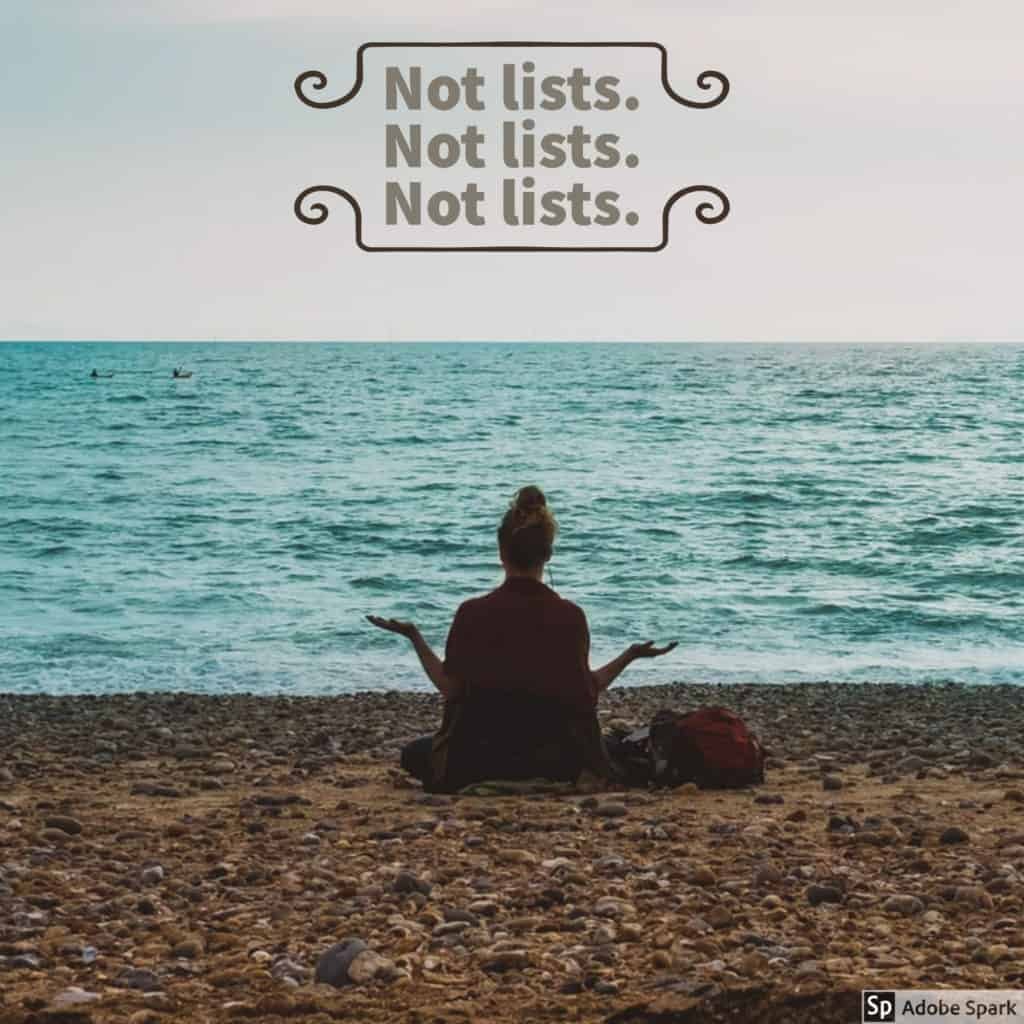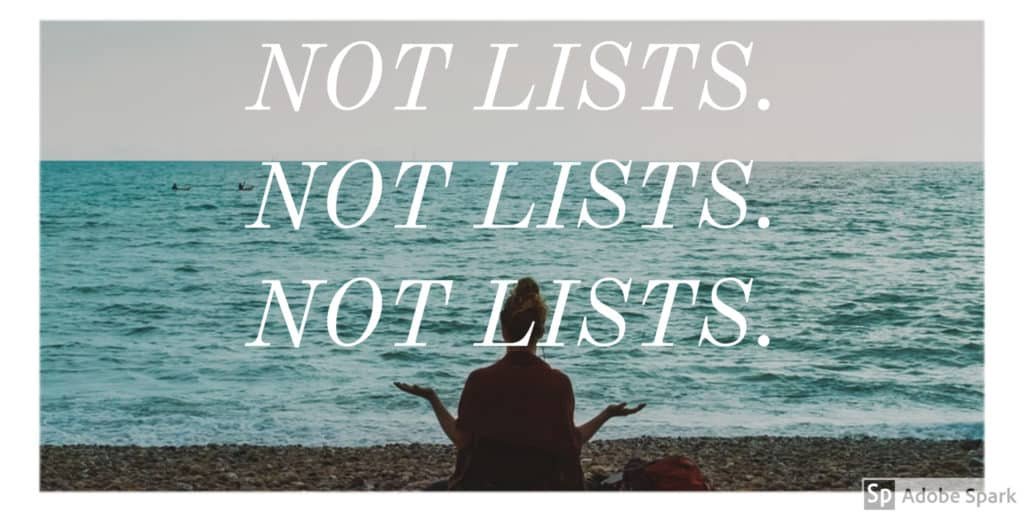This post is about avoiding overthinking through mindfulness meditation. Whoa! Deep. I believe this practice has the power to be life changing. So, bear with me.
As I sat down to write this, here is what I have discovered in the last 5 minutes:
- The framed photo that’s hanging on my wall is crooked.
- From my window, I just spotted a guy running on the road. He’s flying. I can never run that well. Why am I so untalented? Poor genes, for sure. I blame my entire genetic pool.
- My right eye is twitching slightly. Wonder why? Does it denote bad luck? Is it a harbinger of something more serious? I hope not since I want to avoid hospitals during this time.
- I stare at my bookshelf. Why are there are SO MANY unread books? Gosh, will I ever have the time? 3 books on making bread? Never made bread my entire life. Got to put that on my list.
- Oh no. The list!!!!!
The English dictionary has a word for this. “Scatterbrained”. My middle initial is ‘S’. Rightly so. My parents were so prescient! Scatterbrained would be a perfect middle name for me.
Now, ready for some irony? The topic I sat down to write is about avoiding overthinking through mindfulness meditation. But right now, my mind wants to be anywhere else but here.
Overthinking
We think about 60,000 – 80,000 thoughts a day. That’s right. Roughly 2500 thoughts an hour. Accounting for sleep would make that an even greater number during waking hours. And, the bothersome part? Most thoughts aren’t voluntary. They just pop into our heads, often times without invitation. Okay, I know you’re going to say “that’s how inspiration strikes”. Maybe. But I can tell you 99% of the time it is simply mundane stuff.
Creating stories
It’s not the thoughts themselves that are a problem. It is how they drag us into their stories. It’s how we spin in them. Consider this example:
6:02 pm: I text a friend about meeting up in a couple of days.
6:03 pm: I head off to the kitchen to make dinner.
7:30 pm: Dinner and dishes are done and I check my phone but no response from said friend.
7:35 pm: I see a social media post from the same friend, timestamped 6:48 pm.
7:36 pm: I think – ‘Maybe she did not see my text. I’ll wait’.
7:40 pm: Scroll through her feed and another post from the same friend at 7:15 pm.
7:42 pm: Remember the last conversation I had with her. It kind of ended abruptly because I cut it short since I had an important appointment to leave for.
7:45 pm: Now, I’m, starting to get bothered. Is she trying to ignore me? Well, that kind of makes sense from her perspective, right?
7.48 pm: Should I call her or text her again?
7:50 pm: Nope. Too needy. Just wait.
8:00 pm: Ok. She hates me. Serves me right. I need to treat relationships better.
8:20 pm: Me (aggressively folding laundry): What right does she have to treat me like that? I’m making a serious effort here. If she doesn’t care, then I don’t either. I have better things to do.
8:30 pm: Me: Ugh, I hate confrontation and unpleasantness. Wish I hadn’t texted at all.
And I spend the night in a bad mood, taking it out on myself and my poor family. That’s hours of my life spent on thoughts that aren’t helpful.
Our thinking brains
The key takeaway in the above story is that I constructed it all in my imagination. I don’t know the truth one way or the other.
The power to think and reason is the pinnacle of evolutionary success. It’s what distinguishes us from sea urchins. But it’s a double-edged sword. We constantly use past data (experiences) to construct future scenarios (projections) losing sight of the present.
So, what is the leap of faith required for us to acknowledge the thought but not construct a story? How do we separate fact from hypothesis?
Analysis – Paralysis
You feel the onset of a headache. At first you treat it like a headache. You hear the story of a colleague dropping cold in the office with a brain aneurysm. Now, you think, could the headache be due to a brain tumor? It may or may not be. It most likely is not.
Logically, if you notice frequent headaches, here’s what you would do:
- Notice headache
- Make an appointment to see the doctor
- Doctor orders tests
- You get tests done
- Doctor calls you with results.
Between (a) and (e) two things happen – the passage of time and ever-increasing anxiety. During that time, you have written a Pulitzer-worthy novel in your head. I bet it has a tragic plot and plenty of equally catastrophic sub-plots. How do I know? I have so many Pulitzers that I have run out of display room.
There is a name for the condition that happens between (a) and (e). It’s called Life. And we only have this one now. Bummer!
I’m not arguing that there is no place for thought. I’m saying we need to learn to ‘just be’. In the moment. Let me emphasize one undisputable fact of life. Time is THE most precious resource we have. And yet, somehow, we don’t hesitate in squandering it away. Not asking you to micromanage every second of every day. Quite the contrary. Simply understand that this moment is all we have. Just while you read that sentence, a couple of seconds have passed, one that you’ll never get back. Brutal.
So how do we try to live in the present, while our thoughts are consistently rocking us back between the past and future, swinging like spider monkeys moving from one tree to another?

Mindfulness Meditation
This is where the concept of avoiding overthinking through mindfulness meditation come in. You knew this was coming. So, let’s get on with it.
First, some key definitions.
Mindfulness is the ability to simply be in the moment.
Meditation is the tool to help us with the practice of mindfulness. Technically, there are many forms of meditation. But the one that I’m discussing is Mindfulness meditation.
The practice of meditation does not require JEDI-type mind control but just getting into the habit of observing and noticing the present moment. If you can sit in a lotus position and focus on the same object for 30 minutes with an unwavering mind, you’re probably a monk in a monastery and will never come across this essay. This is for us mere mortals dealing with life’s constant pulls and grasps.
What happens when you meditate?
To be quite honest, initially, just a lot of fidgeting and falling asleep. For me, it’s thinking about lists. It’s always about lists.

But gradually, if you keep up the practice, tremendous benefits occur in the long run. Stress reduction, anxiety control, improved concentration and memory, emotional balance etc. The list goes on and on. Study after study has shown how the brains of successful meditators physically change. fMRI (Functional Magnetic Resonance imaging) studies show how neural pathways light up differently in meditator’s brains than in those that don’t.
I cannot extol the virtues of this practice enough in this one post. Any skeptics are welcome to do their own research. There are no downsides to trying the practice other than an unscheduled short nap.
If we had this in pill form today, I bet you, this would be THE #1 blockbuster pharmaceutical drug on the planet.
And yet, why don’t we practice it? Because it takes time and practice. Something our commitment-phobic brains don’t like.
How to meditate?
There are countless apps and books out there that teach you to meditate. And many different traditions. For beginners, my recommendation is to go with a guided meditation app or an expert teacher.
Paying attention to our own breath is the most common way to practice initially because it lets us focus on something we all have. The goal, ultimately, is to simply be.
Start by focusing on your breath. When a thought comes in, acknowledge it, notice it, but go back to the breath. The metaphor of a passing cloud is often used to describe these thoughts. Thoughts come and go like passing clouds. No point pretending they are not there. But neither is there a reason to engage or get absorbed in them. Here is how I internalized it “Watch the cloud. Don’t ride the cloud”. Tempted, as you may be.
That’s all fine and dandy. How do I know it’s working?
The key is to find the Zen in real-life situations. Not just while secluded on a mat. And that comes with practice. The more practice on the mat, the better equipped to respond you’ll be when life hands you lemons.
Essentially, this is what happens:
Before mindfulness training: Trigger → Response
After mindfulness training: Trigger → Pause/Notice → Response
This Pause will allow you to put distance between the trigger and your response. I discussed the important role mindfulness plays in my previous post http://partably.com/part-2-intentional-timewasting/ on habit formation.
To paraphrase one of my favorite Buddhist teachers on meditation, Pema Chodron, “Let’s say you notice a fire. When it’s an ember, you have time to put it out. If you don’t notice the ember and the whole house is on fire, it simply crashes and burns”. Noticing embers is what mindfulness is all about.
The more you train the mind to be in the present, the less you will be absorbed into the vortex of stormy thoughts. Avoiding overthinking through mindfulness meditation is not easy by any means. But when you get there, it’s a beautiful thing. For you and everyone else around you. I have witnesses who’ll attest to this fact.
Conclusion
To conclude, I cannot resist borrowing a very recent quote from our current commander-in-chief. “What do you have to lose?” “It’s been out there for a long time. What do you have to lose? I hope they use it.” (For context see footnote 1. Also, note that my recommendation is based on hard evidence-based science).
Hopefully this post on avoiding overthinking through mindfulness meditation has stuck a chord with you. Please share your experience, feedback and comments. I truly value them.
PS: Regarding the episode with my friend who in my mind had “scorned” me. She called me the next day when she saw my message. We caught up over coffee eventually that weekend. All’s well and our friendship is good. Turns out she had not seen my text the evening I had sent. She was practicing mindfulness by turning off her message notification while on social media. I mindfully tried not to judge.
- ‘What have you got to lose?’ Trump tells coronavirus patients to ‘try’ unproven drug. https://www.nytimes.com/2020/04/04/health/coronavirus-drug-trump-hydroxycholoroquine.html


Dolly – thank you! That’s very high praise indeed. Yes, we are all learning to be mindful. Slowly but surely.
You are not only a great writer but a great thinker…. That’s how you can break up so many complex thoughts and present them so easily in simple language….
Mind games are the worst enemy… And we mindfully have to stay positive…
Regarding genes, I hope Ahana has got this gene from you… 🙂